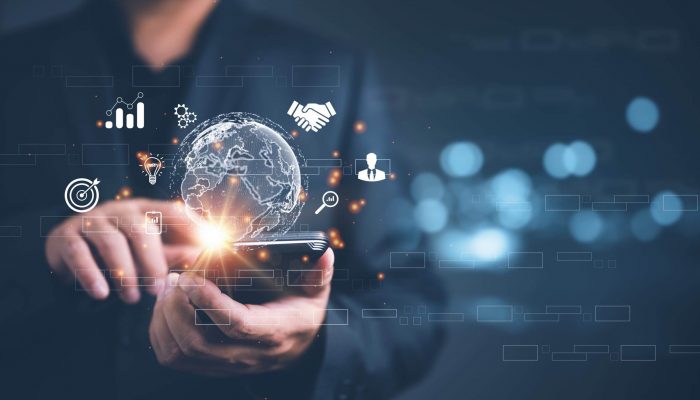We’ve learned valuable lessons since 2020 about resilience: endurance favors those who are prepared, agile and proactive about change. There’s more to the story, though. To truly thrive in this new world of work, businesses must also create value across the entire organization for a better company culture and customer experience.
Simply put, technology must leap beyond the expected and help craft business resiliency in human terms.
Accelerated digitalization is triggering sweeping changes across many industries: health care, manufacturing, retail, automotive, public sector, finance and banking, just to name a few. With change comes a new game plan for building enterprise resiliency.
Mobility solutions is the technology tool to watch, particularly as the number of IoT devices continues to grow, and the connected smartphone remains a hub in both our personal and work lives.
The story of how connectivity is rapidly evolving begins with 5G cellular networks. In Gartner’s report entitled “Top Trends Driving Enterprise Mobility for 2022,” 5G is predicted to reach 90% of the U.S. population in 2023 (along with Australia, Canada, China, Japan, New Zealand and South Korea; the report predicts other countries will adopt 5G by 2026). While going from 3G to 4G LTE was about speed, 5G is about reimagining possibilities.
With 5G comes mobile solutions that defy how business is conducted today, inspiring meaningful engagement in almost unimaginable ways: customer messaging where and when needed, real-time communication with team members, greater uptime regardless of where people work, mobile security minimizing risk, augmented reality that deepens experiential impact, vehicle-to-everything communication (as well as other transportation mediums like railways), the use of AI in the contact center, and 24/7 access to information tailored to the schedules and lifestyles of real people.
Connecting people in new and different ways
As a board member to several organizations, resilience is a topic I hear talked about often by colleagues. In my view, the magic comes from how you use technology to serve others. Mobility solutions empower employees to succeed and, in turn, help their customers succeed. This, to me, is both hopeful and exciting.
In the age of remote and hybrid work, mobile technology has the ability to create stronger relationships and increase employee satisfaction in ways we haven’t seen before.
Gartner’s report, in fact, points out: “The shift to more remote work in the wake of the pandemic has led organizations to move mobile investment to new use cases.” Augmented reality (AR), virtual reality (VR), mixed reality (MR), AI and cognitive, and metaverse (described as a “successor to the mobile internet” by Facebook founder Mark Zuckerberg who gives the comparison of sending his parents a picture of his family today while in the metaverse his parents can interact with their grandchildren without leaving home) can enable stakeholders and employees to interact more fully and collaborate with ease.
An upcoming event doing a deep dive into these topics is Enterprise Connect March 21-24 in Orlando. Among its speakers, Jason Inskeep, director of 5G Center of Excellence at AT&T, is on a star-studded panel dishing up how mobility technologies are developing, and where they might present new options as the workforce evolves and potentially becomes more dispersed. He will also be addressing the hot topic of private 5G as well as rural broadband alternatives to cable modem and fiber. His talk is entitled “Mobility Update: Sizing Up 5G (and Alternatives) in the Real World.”
According to AT&T’s website, 5G will “shift the paradigms for industries and accelerate consumer experiences.” I like, however, that they have dubbed this moment in history as the “new industrial revolution.” Just as with the first and second industrial revolutions, there will be business winners and losers. Organizations shaping a sound mobile strategy have the greatest potential for business resiliency.
Prioritizing your team
According to the Labor Department, 47 million quit their jobs in 2021. Perhaps the pandemic inspired people to reevaluate their priorities and options. Gallup found that engagement is highest for “workers who spend three to four days working remotely.” Imagine that. From a crisis came a new workplace paradigm.
Working remotely does not, however, equate to working alone. AT&T Workforce Manager, for example, is a multi-faceted platform that empowers remote and hybrid workers with wireless forms, instantaneous order and mobile timekeeping. For employees living in areas with unpredictable Wi-Fi, AT&T also has solutions to boost indoor wireless coverage (OK, this doesn’t help if you’re working on the beach, but it will help if you work out of the beach house!).
For the resilient enterprise, creating a fluid workforce means prioritizing your team and embracing a mobile strategy for remote and hybrid workers so they are productive, connected, and happy.
A final thought
I believe people thrive at the crossroad of humanity and technology. If technology does not serve real people, then technology fails, and we falter too by not living up to our greatest potential.
Equip your team with tools and knowledge to achieve what technology alone cannot. Inspire your team to dive into the waters of meaningful engagement – being there in a customer’s greatest moment of need, collaborating with coworkers to solve problems faster, and, sometimes, just sharing a kind word when that alone will turn around someone’s day. An early author of self-help books, Napoleon Hill, writes: “It is literally true that you can succeed best and quickest by helping others to succeed.” This is what will make great companies stand the test of time. This is truly the path to enterprise resilience.
This post was sponsored by AT&T Business, but the opinions are my own and don’t necessarily represent AT&T Business’s positions or strategies.

